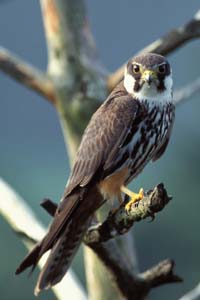ERROR : Server Busy(-1105)
ERROR : Server Busy(-1105)
Eurasian Hobby (Falco subbuteo) - Wiki
Eurasian Hobby
From Wikipedia, the free encyclopedia
Order: Falconiformes
Family: Falconidae
[Photo] Eurasian Hobby (Falco subbuteo) adult. Image d'un Faucon hobereau adulte pos?? sur une branche. Photo by Polo7. Source: http://en.wikipedia.org/wiki/Image:Faucon_hobereau.jpg | Permission is granted to copy, distribute and/or modify this document under the terms of the GNU Free Documentation License, Version 1.2 or any later version published by the Free Software Foundation; with no Invariant Sections, no Front-Cover Texts, and no Back-Cover Texts. A copy of the license is included in the section entitled "GNU Free Documentation License". |
The Eurasian Hobby (Falco subbuteo), or just simply Hobby, is a small slim falcon. It belongs to a rather close-knit group of similar falcons often considered a subgenus Hypotriorchis.
This species breeds across Europe and Asia. It is a long-distance migrant, wintering in Africa.
Adults are slate-grey above, and streaked lengthwise below, with a white throat. Close views enable the red "trousers" and vent to be seen. Sexes are similar, but juveniles are generally much browner.
It is a bird of open country such as farmland, taiga and savannah. They are widespread in lowlands with scattered small woods.
It is an elegant bird of prey, appearing sickle-like in flight with its long pointed wings and square tail. It will take large insects, such as dragonflies, which are transferred from talons to beak and eaten in flight. It also captures small birds in flight. Its speed and aerobatic skills enable it to take swallows and even swifts on the wing, and Barn Swallows or House Martins have a characteristic "hobby" alarm call.
Hobbies nest in old nests of crows and other birds, laying 2-4 eggs.
A range of board games was also once going to be named "Hobby", but the inventor was refused permission by the Patent Office. This inventor, who was also a birdwatcher, simply used the scientific name of the Hobby and called the board game Subbuteo.
http://en.wikipedia.org/wiki/Eurasian_Hobby
| The text in this page is based on the copyrighted Wikipedia article shown in above URL. It is used under the GNU Free Documentation License. You may redistribute it, verbatim or modified, providing that you comply with the terms of the GFDL. |
|

